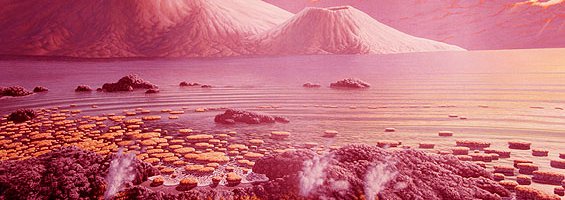Written byAaron Gronstal

April 12, 2017
Research Highlight
New Insight into Atmospheric Chemistry on the Ancient Earth

Artist impression of Earth during the Archean eon.Image credit: Peter Sawyer / Smithsonian Institution.
A new study could help astrobiologists understand the environment of the ancient Earth more than 2.3 billion years ago. The research focuses on the mass-independent fractionation of sulfur isotopes that took place in the Archean atmosphere, and offers a possible mechanism for its occurrence. Mass-independent isotope fractionation is a process by which isotopes of a chemical element are separated on a scale that is not in proportion to the difference in their masses. This type of fractionation is not common, but can be seen in nature with isotopes of oxygen and sulfur.
The rock record of Earth provides evidence that this relatively rare type of fractionation occurred in the Archean atmosphere, and scientists have been trying to tease out just how it happened in order to better understand atmospheric chemistry on our planet billions of years ago. A new study by Dmitri Babikov at Marquette University presents a possible mechanism for this process at the molecular level, and will help shed new light on Earth’s ancient environment “just before, at the time of appearance, and during the evolution of early life.”
The paper, “Recombination reactions as a possible mechanism of mass-independent fractionation of sulfur isotopes in the Archean atmosphere of Earth,” was published in the Proceedings of the National Academny of Science (PNAS). The research was supported by the Exobiology and Evolutionary Biology element of the NASA Astrobiology Program.